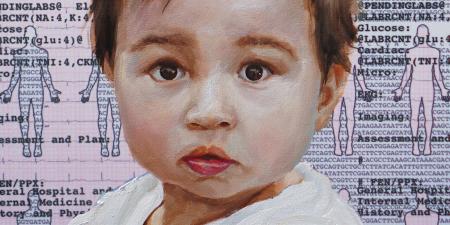Abstract
Humans exploring beyond low-Earth orbit face environmental challenges coupled with isolation, remote operations, and extreme resource limitations in which personalized medicine, enabled by genetic research, might be necessary for mission success. With little opportunity to test personalized countermeasures broadly, the National Aeronautics and Space Administration (NASA) will likely need to rely instead on collection of significant amounts of genomic and environmental exposure data from individuals. This need appears at first to be in conflict with the statutes and regulations governing the collection and use of genetic data. In fact, under certain conditions, the Genetic Information Nondiscrimination Act (GINA) of 2008 allows for the use of genetic information in both occupational surveillance and research and in the development of countermeasures such as personalized pharmaceuticals.
What Is the Genetic Information Nondiscrimination Act?
Anticipating the rapid development of genomics and its implications for both use and misuse, in February of 2000, President William J. Clinton signed Executive Order (EO) 13145, which prohibited genetic discrimination in the federal workplace. The EO barred discrimination based on genetic information, while allowing federal employers to conduct genetic testing for use in occupational surveillance and in other human research conducted under the Common Rule.1 Eight years later, in 2008, the passage of the Genetic Information Nondiscrimination Act (GINA) extended the EO’s protections beyond the federal government to the general public and beyond employment to health insurance.2 Ten years after the passage of GINA, the National Aeronautics and Space Administration (NASA) has just begun to seriously engage with genomics as a means to understand and mitigate the health consequences of space flight.
GINA’s protections are broad: it prevents employers from using genetic information for hiring, firing, or promotion decisions and for any decisions regarding terms of employment. In the context of the human spaceflight program, GINA prevents NASA from collecting and using genetic information to determine whether an applicant will be selected to become an astronaut and whether an astronaut is qualified for assignment to a particular mission.
Although genetic information cannot legally be used to determine eligibility for employment, it is likely to become critical for some types of occupational surveillance and for mitigating some occupational risks. Genetic research is becoming critical to understanding differences in patients’ responses to treatments and to predicting individuals’ responses to targeted therapy,3 tasks made more complex when the goal is to understand and protect workers from negative health impacts of occupational environments. Despite more than 7 decades of human spaceflight, NASA astronauts work in a unique and poorly characterized environment. With limited opportunities to test personalized countermeasures before sending humans on a 2-year trip to Mars, NASA will need to rely instead on collection of significant amounts of genomic and environmental exposure data from individual astronauts.4
Collecting genetic information for the purpose of occupational surveillance appears at first to be in conflict with statutes and regulations governing the collection and use of genetic data just discussed. In fact, under certain conditions, GINA allows for use of genetic information in both research and occupational surveillance and in developing countermeasures such as personalized pharmaceuticals.
Application of GINA to NASA
NASA currently collects little genetic information about astronauts, but it is actively exploring how genetic information might improve understanding of health risks of spaceflight and mitigate those risks. As applied to NASA, GINA governance of collecting genetic information is complicated by that fact that NASA does not fit neatly into any of the categories defined in GINA; rather, NASA plays several roles. NASA is an employer that makes employment and flight selection decisions; it is a clinical care provider insofar as it provides primary care and health maintenance to the active astronaut corps, ongoing surveillance of former astronauts, and flight medicine support during training and flight; it performs occupational health surveillance and wellness promotion by monitoring and characterizing the influences of space environment hazards on crew and seeking to train and prepare crew members appropriately; and it is a research organization that performs fundamental and applied research to understand—and develop countermeasures to minimize—unique harms of the spaceflight environment, such as toxic radiation and microgravity exposure. NASA is permitted to collect genetic information in the course of providing clinical care, providing occupational surveillance and protection, and doing research to ensure the health and safety of future explorers. This collection process must be consistent with the statutory requirements of GINA as well as those of the Privacy Act of 1974,5 which defines government obligations to protect personal information in federal records; the Common Rule,6 which establishes ethical requirements for human subject research; and Occupational Safety and Health Administration (OSHA) guidelines,7 which mandate how employers must protect workers’ health.
NASA’s Collection of Genetic Information for Research
GINA’s rules do not limit the authority of a federal department or agency to conduct or sponsor occupational research or other health research under the Common Rule.8 Equal Employment Opportunity Commission (EEOC) federal regulations, which interpret GINA, state that GINA should be construed so that it does not “limit the authority of a Federal department or agency to conduct or sponsor occupational or other health research.”9
The astronaut corps is a unique employee population. Small in number and highly visible in the public eye, astronauts face special challenges maintaining the privacy and confidentiality of their data. NASA’s policy on genetic research recognizes these challenges and places significant restrictions on how genetic information gathered as part of research is used and shared.1 Participation in genetic research is voluntary, and NASA is keenly aware of the potential for actual or perceived coercion in an environment of limited flight opportunities. As a result, NASA maintains rigorous informed consent processes overseen by the NASA Flight Institutional Review Board (IRB). Control over access to retrospective data is maintained by the Lifetime Surveillance of Astronaut Health (LSAH) advisory board, which is delegated authority from the system of records administrator.
One recent and well-publicized example of genetic research on astronauts is the Twins Study,10 an ambitious research program using personalized medicine techniques to discern individual responses to long-term exposure to a spaceflight environment. The Twins Study is the first of its kind and compares the molecular profile of a pair of identical twins, Scott and Mark Kelly, one current and one former astronaut, while one spent a year in space and the other remained on Earth. The study is a series of 10 separate studies that attempt to link genetic, epigenomic, proteomic, and metabolomics data at a molecular level to whole-body and brain function at a macroscopic level. Insights gained from this research are expected to inform how NASA defines its occupational surveillance needs and its approach to countermeasures for mitigating risks of spaceflight. Because of the very small sample size of the study and the highly identifiable nature of both subjects, there was no option that would protect their privacy and preserve the confidentiality of their health information. The twin who flew in space during this study—the first US 1-year crew member—retired from NASA shortly after his flight. As a result of all these factors, NASA’s ability to demonstrate its capacity to protect research data from improper use was not tested.
NASA’s Collection of Genetic Information for Occupational Surveillance
Unlike the voluntary nature of their participation in research, crew cannot opt out of occupational surveillance, which is part of the provision of health care. Occupational surveillance differs from research governed by the Common Rule. The Common Rule defines research as “a systematic investigation, including research development, testing and evaluation, designed to develop or contribute to generalizable knowledge.”11 Occupational surveillance, intended only for use within NASA to inform its understanding of the hazards associated with human spaceflight and to develop countermeasures against those hazards, does not meet this criterion.11 Genetic data collected as a part of NASA’s occupational surveillance must be properly safeguarded to ensure its storage and use in accordance with GINA and the Privacy Act.
As a part of occupational surveillance, GINA allows employers to collect genetic information to monitor biological effects of toxic substances in the workplace.12 The space environment, an astronaut’s workplace, contains inherently dangerous conditions such as exposure to radiation and microgravity. For instance, the US Department of Health and Human Services’ Agency for Toxic Substances and Disease Registry classifies ionizing radiation as a toxic substance.13 Collecting genetic information to monitor the impact of the hazardous space environment on astronauts and in ground analogs is consistent both with GINA’s allowance for collecting genetic information for occupational surveillance and with the toxic substances exemption from OSHA’s general prohibition on collecting genetic data.12
The EEOC and GINA specify that employers may only acquire genetic information for use in monitoring biological effects of toxic substances in a workplace under specific conditions.12 Under GINA, an employer must provide written notice of monitoring to the employee, and the employee must be informed of the monitoring results. An employer may not retaliate or otherwise discriminate against employees due to their refusal to participate in genetic monitoring, and employees must give prior knowing, voluntary, and written authorization. Finally, an employer may only obtain results in the aggregate.14 Currently, NASA has not begun collecting genetic information for genetic monitoring. It is likely, however, to do so in the near future. Compliance with GINA will be feasible in all respects except one: aggregation of data.
NASA collects health data on individual employees, and it is responsible for the Privacy Act systems of records in which employees’ clinical and research data are stored. By definition, NASA would have access to genetic information collected from individually identifiable astronauts. The small number of astronauts and the importance of understanding individual genetic differences make it difficult to aggregate and anonymize genetic information. In our view, applying the GINA requirement for aggregated data would limit NASA’s authority to conduct occupational and health research and thus would be invalid as applied to NASA’s occupational and health research activities. Because of the small number of astronauts and the necessity of matching an individual’s genetic information to that individual’s specific exposures, such as time in space and radiation events, once NASA begins collecting individuals’ genetic information, the data cannot be both aggregated and useful for identifying health impacts from the hazards of spaceflight and for developing countermeasures.
NASA can maintain safeguards currently in place that segregate clinical data from research data and regulate processes of selecting and qualifying crew for flight assignments. Access to clinical and research health records are moderated through several NASA boards that make need-to-know determinations for identifiable records, ensure that proper consent is obtained if data is used for research purposes, and verify that NASA’s epidemiologists have anonymized data sufficiently to allow its release to requestors. These same processes could be used to ensure that genetic information is logically segregated from other health data in electronic health records and not released for purposes of making medical qualifications for flight decisions. NASA has already removed questions relating to family medical history (which is considered genetic information) from its astronaut selection processes. NASA can also implement privacy measures that would protect astronauts from discrimination.
Genetic Information as a Part of Occupational Health
GINA and EEOC regulations also support collection and use of genetic information for health care delivery and apply to NASA as the primary health care provider for the astronaut corps. GINA’s prohibitions against requesting or collecting genetic information do not apply to employers that offer health or genetic services, provided such services “are reasonably designed to promote health or prevent disease.”15 NASA’s Flight Medicine Program is an occupational health program designed to identify and treat injury and illness resulting from occupational exposures during training and spaceflight, maintain optimal health and performance of NASA’s astronauts, and support development of measures to counter long-term health effects of space flight. Thus the program meets the OSHA regulatory exemption from the general prohibition on collecting genetic data for employers that offer health services designed to promote health and prevent disease.12 Currently, NASA’s flight medicine program does not collect genetic information other than family history, which supports clinical care. Once it begins to collect genetic data, those data will become part of an astronaut’s health record and part of the system of records discussed above. Those data, like all clinical data, are available for use in treating individual astronauts and for occupational surveillance of the astronaut corps as a whole. Like genetic data collected for research, these data are also walled from consideration for flight selection purposes.
Genetic information will be critical to protecting crew members’ health as NASA moves from low-Earth orbit to planetary exploration missions. Personalized countermeasures developed through efforts like pharmacogenomics will be necessary as NASA sends humans on multiyear missions with fully autonomous medical systems and no resupply or medical evacuation capability. For example, general medication safety and efficacy is highly variable among patients in space. The European Space Agency recently found that individual response to roughly one-third of drugs currently available on the International Space Station is affected by polymorphic metabolizing enzymes.16 This finding suggests that tracking and using individual astronauts’ genetic information could lead to a significantly more effective and personalized pharmacy for future exploration missions. Personalized pharmacies will minimize the chance of providing ineffective medications to crews unable to access alternative medications due to the remote nature of their missions. Since exploration missions will be extremely resource constrained, allowing NASA to fly only the most effective medications for the assigned crew will make room for a broader onboard formulary.
As mentioned, GINA generally prohibits employers from receiving genetic information collected for the purpose of providing care, except in the aggregate. However, there is a specific exception for circumstances that make data aggregation impossible, such as when the number of subjects is so small that information is readily identifiable with no effort on the employer’s part.17 Criteria for this exception are met in the case of astronauts. For reasons discussed above, it would be impossible to aggregate data and accord the regulatory exception. As a result, we believe that NASA may properly collect individualized genetic data for clinical purposes. Even so, NASA may only use collected data for activities not prohibited by GINA, such as the provision of health care, occupational surveillance and research, and development of countermeasures—not for astronaut selection or flight assignments.
Protecting and Treating Astronauts While Avoiding Discrimination
As NASA looks to expand the reach of human exploration to Mars and beyond, human health will be one of the most significant risks to mission success. As a result, expanding the frontiers of human exploration is closely tied to expanding the frontiers of medicine. Exploring Mars and someday beyond our solar system will require advanced autonomous medical capabilities and personalizing medicine to respond to needs of individual crew members in their unique work environments. Genetic information and research is critical to enabling these advances and to protecting the health of future explorers. NASA’s particular challenge arises in striving to meet its ethical and legal obligations to each astronaut whose genetic information will be collected. As a primary care provider, employer, and research investigator, NASA will need to create appropriate information and policy structures to ensure that genetic information is used to protect and treat members of the astronaut corps, not to discriminate against them unjustly.
References
-
Executive Order 13145—to prohibit discrimination in federal employment based on genetic information. Fed Regist. 2000;65(28):6877-6880. https://www.gpo.gov/fdsys/pkg/FR-2000-02-10/pdf/00-3331.pdf. Accessed April 12, 2018.
-
Genetic Information Nondiscrimination Act of 2008, Pub L No. 110-233, 122 Stat 881.
- Hamburg MA, Collins FS. The path to personalized medicine. N Engl J Med. 2010;363(4):301-304.
- Schork NJ. Personalized medicine: time for one-person trials. Nature. 2015;520(7549):603-611.
-
Privacy Act, 5 USC §552a (1974).
-
45 CFR part 46, subpart A (2017).
-
29 CFR part 1910 (2017).
-
29 CFR §1635.11(a)(5) (2010).
-
Regulations under the Genetic Information Nondiscrimination Act of 2008. Fed Regist. 2010;75(216):68912-68939. https://www.gpo.gov/fdsys/pkg/FR-2010-11-09/pdf/2010-28011.pdf. Accessed April 12, 2018.
-
NASA. Twin study. https://www.nasa.gov/twins-study. Updated March 26, 2018. Accessed April 12, 2018.
-
45 CFR §46.102(d) (2009).
-
29 CFR §1635.8 (b)(5) (2010).
-
Agency for Toxic Substances and Disease Registry, Centers for Disease Control and Prevention. Toxic substances portal. https://www.atsdr.cdc.gov/substances/toxsubstance.asp?toxid=86. Accessed January 27, 2017.
-
29 CFR §1635.8 (b)(5)(i) (2010).
-
29 CFR §1635.8 (b)(2)(i)(A) (2010).
-
Stingl JC, Welker S, Hartmann G, Damann V, Gerzer R. Where failure is not an option—personalized medicine in astronauts. PLoS One. 2015;10(10):e0140764. doi:10.1371/journal.pone.0140764.
-
29 CFR §1635.8 (b)(2)(i)(E) (2010).



